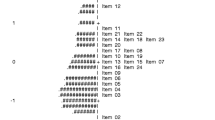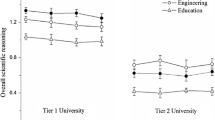Abstract
The focus on STEM has centered on knowledge use across multiple disciplines. However, there currently exists limited understanding of the relationship between the cognitive practices utilized across these disciplines as a function of performance on standardized assessments. Focusing on science and mathematics, we investigated the direct and indirect relationships between science and mathematics reasoning practices. The TIMSS 2011 cognitive practices were adopted to establish a hypothesized model representing these relationships. We employed the generalized DINA (deterministic inputs, noisy “and” gate), confirmatory factor analysis (CFA), and structural equation modeling (SEM) to 2287 fourth-graders’ responses to standardized mathematics and science assessments. The findings show positive relationships among science reasoning, mathematics reasoning, and mathematics applying. However, we also found a significant indirect effect from science reasoning to mathematics reasoning through mathematics applying. This result calls for a need to shift the focus of interdisciplinary efforts to emphasize cognitive practices that students use in learning mathematics and science as suggested in the Next Generation Science Standards and the Common Core State Standards for Mathematics.
Résumé
L'accent mis sur les STEM s’est jusqu’à maintenant concentré sur l'utilisation des connaissances dans diverses disciplines. Cependant, la compréhension de la relation entre les pratiques cognitives utilisées dans ces disciplines en fonction de la performance aux évaluations standardisées est actuellement limitée. En mettant l’accent sur les sciences et les mathématiques, nous avons étudié les relations directes et indirectes entre les pratiques de raisonnement scientifique et mathématique. Les pratiques cognitives TIMSS 2011 ont été adoptées pour établir un modèle hypothétique représentant ces relations. Nous avons eu recours à G-DINA (deterministic inputs, noisy « and » gate), à l'analyse factorielle confirmatoire (AFC) et à la modélisation d'équations structurelles (MES) pour étudier 2 287 réponses d’élèves de quatrième année à des évaluations normalisées en mathématiques et en sciences. Les résultats indiquent des relations positives entre le raisonnement scientifique, le raisonnement mathématique et l'application des mathématiques. Cependant, nous avons également observé un effet indirect significatif du raisonnement scientifique sur le raisonnement mathématique par le biais de l’application des mathématiques. Ce résultat illustre la nécessité de réorienter les efforts interdisciplinaires pour mettre l'accent sur les pratiques cognitives que les élèves utilisent pour apprendre les mathématiques et les sciences, comme le suggèrent les Next Generation Scientice Standards et les Common Core State Standards for Mathematics.



Similar content being viewed by others
References
Adey, P., & Shayer, M. (2015). The effects of cognitive acceleration. In L. B. Resnick, C. S. C. Asterhan, & S. N. Clarke (Eds.), Socializing intelligence through academic talk and dialogue (pp. 127–140). Washington, DC: American Eduactional Research Association.
de Ataide, A. R. P., & Creca, I. M. (2013). Epistemic views of the relationship between physics and mathematics: Its influence on the approach of undergraduate students to problem solving. Science & Education, 22(6), 1405–1421.
Bailin, S. (2002). Critical thinking and science education. Science & Education, 11, 361–375.
Bailin, S., & Siegler, H. (2003). Critical thinking. In N. Blake, P. Smeyers, R. Smith, & P. Standish (Eds.), The Blackwell guide to the philosophy of education (pp. 181–193). Malden, MA: Blackwell Publishing.
Buck, G., VanEssen, T., Tatsuoka, K., Kostin, I., Lutz, D., & Phelps, M. (1998). Development, selection and validation of a set of cognitive and linguistic attributes for the SAT I Verbal: Analogy section (Research Report. No. RR-98-19 ed.). Princeton, NJ: Educational Testing Service.
Byrne, B. M. (1998). Structural equation modeling with LISREL, PRELIS, and SIMPLIS: Basic concepts, applications, and programming. Mahwah, NJ: Lawrence Erlbaum.
Byrne, B. M. (2012). Multivariate applications series: Structural equation modeling with Mplus: Basic concepts, applications, and programming. New York, NY: Routledge.
Choi, K., Lee, Y.-S., & Park, Y. S. (2015). What CDM can tell about what students have learned: An analysis of TIMSS eighth grade mathematics. Eurasia Journal of Mathematics, Science & Technology Education, 11(6), 1563–1577. https://doi.org/10.12973/eurasia.2015.1421a
Choi, K., Seo, K., & Hand, B. (2020). A theoretical model for transfer of intellectual resources between science and mathematics: An empirical study. Manuscript submitted for publication.
Frank, K. A. (2000). Impact of a confounding variable on a regression coefficient. Sociological Methods & Research, 29(2), 147–194. https://doi.org/10.1177/0049124100029002001
Gick, M. L., & Holyoak, K. J. (1987). The cognitive basis of knowledge transfer. In S. M. Cormier & J. D. Hagman (Eds.), Transfer of learning: Contemporary research and applications (pp. 9–46). San Diego, CA: Academic Press.
Godden, D. (2016). Pushing the bounds of rationality: Argumentation and extended cognition. In F. Paglieri, L. Bonelli, & S. Felletti (Eds.), The psychology of argument: Cognitive approaches to argumentation and persuation (pp. 67–83). Milton Keynes, UK: College Publication.
Hand, B., Therrien, W., Villanueva, M. G., Taylor, J., & Shelley, M. (2011). Using an argument-based inquiry approach to learn science: Year 1 results of the science writing heuristic (SWH). Paper presented at the the Conference of the Society for Research on Educational Effectiveness, Society for Research on Educational Effectiveness, Washington, D.C.
Hanna, G. (2000). Proof, explanation, and exploration: An overview. Educational Studies in Mathematics, 44, 5–23.
Hanna, G., & Jahnke, H. N. (2007). Proving and modelling. In W. Blum, P. L. Galbraith, H.-W. Henn, & M. Niss (Eds.), Modelling and applications in mathematics education: The 14th ICMI Study (New ICMI Study Series ed.), pp. 145–152). New York, NY: Springer.
Haskell, R. E. (2001). Transfer of learning: Cognition, instruction, and reasoning. San Diego, CA: Academic Press.
Iowa Assessments. (2015). Research and development guide: Forms E and F. Orlando, FL: Houghton Mifflin Harcourt.
Iowa End-of-Course Assessment Programs. (2010). Released Items: Algebra I. Iowa City, IA: University of Iowa. Retrieved March 15, 2018 from https://itp.education.uiowa.edu/ieoc/ReleasedItems/alg1/Algebra%20I%20Released%20Items.pdf
Kaiser, G. (2017). The teaching and learning of mathematical modeling. In J. Cai (Ed.), Compendium for research in mathematics education (pp. 267–291). Reston, VA: National Council of Teachers of Mathematics.
Kirwan, C. (1995). Reasoning. In T. Honderich (Ed.), The Oxford companion to philosophy (2nd ed., pp. 791). New York, NY: Oxford University Press.
Kline, R. B. (2011). Principles and practice of structural equation modeling (3rd ed.). New York, NY: The Guilford Press.
Kunda, M., McGreggor, K., & Goel, A. (2009). Addressing the Raven’s progressive matrices test of general intelligence. Paper presented at the AAAI Fall Symposium on Multi Representational Architectures for Human Level Intelligence, Washington, DC.
NGSS Lead States. (2013). Next Generation Science Standards: For statees, by states. Washington, DC: The National Academies Press.
Lee, O., Quinn, H., & Valdés, G. (2013). Science and language for English language learners in relation to Next Generation Science Standards and with implications for Common Core State Standards for English language arts and mathematics. Educational Researcher, 42(4), 223–233. https://doi.org/10.3102/0013189X13480524
Li, H., & Suen, H. K. (2013). Constructing and validating a q-matrix for cognitive diagnostic analyses of a reading test. Educational Assessment, 18(1), 1–25. https://doi.org/10.1080/10627179.2013.761522
Long, J. S. (1997). Regression models for categorical and limited dependent variables. Thousand Oaks, CA: SAGE.
Ma, W. de la Torre, J., & Sorrel, M. (2019). GDINA: The generalized DINA model framework. R package version 2.4.0.
Martin, L., & Gourley-Delaney, P. (2014). Students' images of mathematics. Instructional Science, 42, 595–614. https://doi.org/10.1007/s11251-013-9293-2
McKeough, A., Lupart, J., & Marini, A. (Eds.). (1995). Teaching for transfer: Fostering generalization in learning. Mahwah, NJ: Lawrence Erlbaum.
Moshman, D. (2015). Epistemic cognition and development: The psychology of justification and truth. New York, NY: Psychology Press.
Mullis, I. V. S., & Martin, M. O. (2013). TIMSS 2015 assessment framework. Chestnut Hill, MA: TIMSS & PIRLS International Study Center, Boston College.
Mullis, I. V. S., Martin, M. O., Ruddock, G. J., O'Sullivan, C. Y., & Preuschoff, C. (2009). TIMSS 2011 assessment frameworks. Chestnut Hill, MA: TIMSS & PIRLS International Study Center Lynch School of Education, Boston College.
Mulnix, J. W. (2012). Thinking critically about critical thinking. Educational Philosophy and Theory, 44(5), 464–479. https://doi.org/10.1111/j.1469-5812.2010.00673.x
Muthén, L., & Muthén, B. (1998). MPlus (version 7.3) [Computer software]. Los Angeles, CA: Muthén & Muthén.
National Governors Association Center for Best Practices, & Council of Chief State School Officers. (2010). Common core state standards for mathematics. Retrieved July 31, 2013 from http://www.corestandards.org/the-standards/mathematics
Schoenfeld, A. H. (1992). Learning to think mathematically: Problem solving, metacognition, and sense-making in mathematics. In D. Grouws (Ed.), Handbook for Research on Mathematics Teaching and Learning (pp. 334–370). New York, NY: MacMillan.
Schreiber, J. B., Nora, A., Stage, F. K., Barlow, E. A., & King, J. (2006). Reporting structural equation modeling and confirmatory factor analysis results: A review. Journal of Educational Research, 99(6), 323–338. https://doi.org/10.3200/JOER.99.6.323-338
Shelly, M., & Yildirim, A. (2013). Transfer of learning in mathematics, science, and reading among students in Turkey: A study using 2009 PISA data. International Journal of Education in Mathematics, Science and Technology, 1(2), 83–95.
Tatsuoka, K. K. (1995). Architecture of knowledge structures and cognitive diagnosis. In P. D. Nichols, S. F. Chipman, & R. L. Brennan (Eds.), Cognitively diagnostic assessment (pp. 327-359). Hillsdale, NJ: Erlbaum.
de la Torre, J. (2009). DINA model and parameter estimation: A didactic. Journal of Educational and Behavioral Statistics, 34(1), 115–130.
de la Torre, J. (2011). The generalized DINA model framework. Psychometrika, 76(2), 179–199.
de la Torre, J., & Douglas, J. (2004). Higher-order latent trait models for cognitive diagnosis. Psychometrika, 69, 333–353.
Wilkinson, L., & the Task Force on Statistical Inference. (1999). Statistical methods in psychology journals: Guidelines and explanations. American Psychologist, 54(8), 594–604.
Funding
This research was supported in part by a grant from the Institute of Education Science (IES Award No: R305A090094).
Author information
Authors and Affiliations
Corresponding author
Ethics declarations
Conflict of Interest
The authors declare that they have no conflict of interest.
Additional information
Publisher’s Note
Springer Nature remains neutral with regard to jurisdictional claims in published maps and institutional affiliations.
Rights and permissions
About this article
Cite this article
Hwang, J., Choi, K.M. & Hand, B. Examining Domain-General Use of Reasoning Across Science and Mathematics Through Performance on Standardized Assessments. Can. J. Sci. Math. Techn. Educ. 20, 521–537 (2020). https://doi.org/10.1007/s42330-020-00108-4
Published:
Issue Date:
DOI: https://doi.org/10.1007/s42330-020-00108-4




